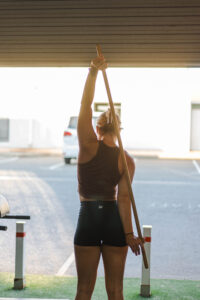
10 Common Mistakes to Avoid in Online Strength Training
10 Common Mistakes to Avoid in Online Strength Training Online strength training programs have revolutionised the way we keep fit, offering flexibility and a plethora

In order to perform well in sports and avoid injuries, flexibility is essential. Whether you play sports for fun or for a living, having high flexibility can improve your overall physical prowess while lowering the chance of injury. In order to maintain your body strong, nimble, and injury-free, we’ll look at practical methods and ideas for increasing flexibility in this blog post.
Dynamic Stretching:
Active actions that gently extend your muscles’ range of motion are used in dynamic stretching. Dynamic stretching, as opposed to static stretching, is done while moving, simulating the movements of your sport or activity. Dynamic stretching aids in preparing your body for the physical demands of your sport by boosting blood flow, easing up the muscles, and improving flexibility.
Static Stretching:
Static stretching is perfect for increasing general flexibility, whilst dynamic stretching is wonderful for warming up. Holding a position for a lengthy time, usually about 30 seconds, is called a static stretch. Major muscle groups including the hamstrings, quadriceps, calves, and shoulders should be your main focus. While stretching, keep in mind to breathe deeply and to relax; do not bounce or push your body above its limits.
Proprioceptive Neuromuscular Facilitation (PNF):
PNF stretching techniques combine muscular contraction with stretching to increase flexibility. This method works very well for improving flexibility and range of motion. The “contract-relax” approach is one well-liked PNF technique. Stretch a certain muscle group first, then contract it for 5–10 seconds before letting go and extending the stretch. To get the most out of this technique, repeat it several times.
Yoga and Pilates:
Holistic exercises like yoga and pilates help people become more flexible, strong, and balanced. Your training programme can benefit from using yoga or Pilates exercises to increase overall flexibility while boosting body awareness and control. These exercises give a balanced approach to flexibility training since they emphasise conscious movement, deep breathing, and moderate stretching.
Foam Rolling and Self-Myofascial Release:
Using a cylindrical foam roller, foam rolling is a type of self-massage that helps to relax tight muscles and fascia. Foam rolling aids in releasing adhesions and knots by applying pressure to particular body parts, improving flexibility and mobility. To improve flexibility and prevent injuries, incorporate foam rolling into your pre-exercise routine or use it as a recovery tool after a workout.
Regular Stretching Routine:
To increase flexibility, one must be consistent. Set aside time each day, or at the very least a few times per week, to carry out a thorough stretching practice. Stretch your entire body, paying special attention to the areas that tend to get tight from your sport or exercise. For the best flexibility benefits, aim for a well-rounded regimen that hits all important muscle groups.
Gradual Progression:
It’s crucial to advance gradually when trying to increase flexibility. To prevent strains or injuries, avoid forcing your body into deep stretches too quickly. Instead, pay attention to your body’s signals, acknowledge its limitations, and gradually increase the length and intensity of your stretching sessions. Better outcomes will come from persistence and patience, which will also lessen the chance of overextending.
The key to improving sports performance and avoiding injuries is flexibility. You can increase your flexibility and lower your risk of sports injuries by using dynamic and static stretching, PNF techniques, yoga or Pilates, foam rolling, and maintaining a regular stretching schedule. Always warm up properly before exercising, and if you have any particular concerns or limits, talk to a trained specialist. Make flexibility training a top priority as a crucial component of your total fitness programme to reap the rewards of a flexible, robust body in your athletic endeavours.
Share on Social Media:

10 Common Mistakes to Avoid in Online Strength Training Online strength training programs have revolutionised the way we keep fit, offering flexibility and a plethora

Eating for Energy: Nutrition Hacks for Personal Training Eating the right foods at the right times can significantly boost your energy levels and enhance your